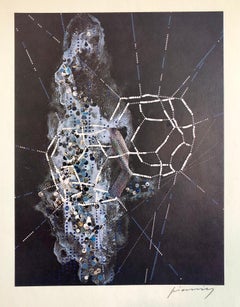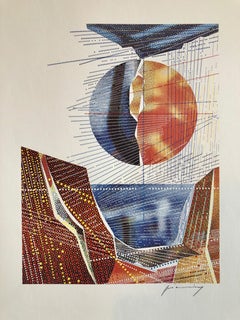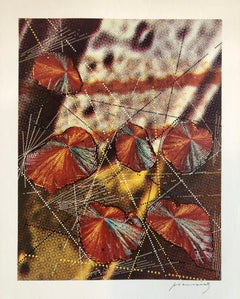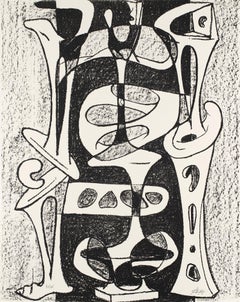M. Peter Piening Art
to
3
Overall Width
to
Overall Height
to
3
3
3
3
3
3
10,138
2,779
1,375
1,369
3
Artist: M. Peter Piening
Pencil Signed Abstract Geometric Graphic Design Lithograph Print, Bauhaus Artist
By M. Peter Piening
Located in Surfside, FL
M. Peter Piening was born on March 14, 1908 in Grabow, Germany. He began his education at a private school in Italy, studied at the Jesuit school of Kloster Ettal in Bavaria, and attended the German Stettin Gymnasium, where he graduated in 1926. Between 1926 and 1928 Piening studied design at the Bauhaus in Dessau, Germany. There he was taught by multiple famous twentieth-century artists, including Joseph Albers, Paul Klee and Mies van der Rohe. After receiving his master’s degree from the Bauhaus in 1929, Piening enrolled at the University of Berlin and obtained his PhD in philosophy in 1931.
Piening spent his early career free-lancing as an illustrator and artist for various publishing companies, eventually settling in Paris to work for Condé-Nast’s French publication of Vogue. In 1934 he moved to the United States to work in Condé-Nast’s New York City office. For the next two decades, Piening worked for many important advertising agencies and magazine publishers, including the N. W. Ayer and J. Walker Thompson agencies and Life and Fortune magazines. As art director for Life in the 1930s and for Fortune in the 1940s, Piening completely redesigned the layout of each magazine. He also redesigned the layouts for thirty-four other major American magazines, including Town & Country and Cosmopolitan.
Through his design work, Piening had a great impact on the American public, although the millions who encountered his work most likely never knew his name. Between 1934 and 1964, Piening designed over sixty logos and trademarks for internationally-known products and companies. His most widely-recognized logo may have been the three interlocking rings of Ballantine beer. Piening’s other trademark designs include the Lincoln Zephyr...
Category
1960s Abstract Geometric M. Peter Piening Art
Materials
Lithograph
Pencil Signed Abstract Geometric Graphic Design Lithograph Print, Bauhaus Artist
By M. Peter Piening
Located in Surfside, FL
M. Peter Piening was born on March 14, 1908 in Grabow, Germany. He began his education at a private school in Italy, studied at the Jesuit school of Kloster Ettal in Bavaria, and attended the German Stettin Gymnasium, where he graduated in 1926. Between 1926 and 1928 Piening studied design at the Bauhaus in Dessau, Germany. There he was taught by multiple famous twentieth-century artists, including Joseph Albers, Paul Klee and Mies van der Rohe. After receiving his master’s degree from the Bauhaus in 1929, Piening enrolled at the University of Berlin and obtained his PhD in philosophy in 1931.
Piening spent his early career free-lancing as an illustrator and artist for various publishing companies, eventually settling in Paris to work for Condé-Nast’s French publication of Vogue. In 1934 he moved to the United States to work in Condé-Nast’s New York City office. For the next two decades, Piening worked for many important advertising agencies and magazine publishers, including the N. W. Ayer and J. Walker Thompson agencies and Life and Fortune magazines. As art director for Life in the 1930s and for Fortune in the 1940s, Piening completely redesigned the layout of each magazine. He also redesigned the layouts for thirty-four other major American magazines, including Town & Country and Cosmopolitan.
Through his design work, Piening had a great impact on the American public, although the millions who encountered his work most likely never knew his name. Between 1934 and 1964, Piening designed over sixty logos and trademarks for internationally-known products and companies. His most widely-recognized logo may have been the three interlocking rings of Ballantine beer. Piening’s other trademark designs include the Lincoln Zephyr...
Category
1960s Abstract Geometric M. Peter Piening Art
Materials
Lithograph
Pencil Signed Abstract Geometric Graphic Design Lithograph Print, Bauhaus Artist
By M. Peter Piening
Located in Surfside, FL
M. Peter Piening was born on March 14, 1908 in Grabow, Germany. He began his education at a private school in Italy, studied at the Jesuit school of Kloster Ettal in Bavaria, and attended the German Stettin Gymnasium, where he graduated in 1926. Between 1926 and 1928 Piening studied design at the Bauhaus in Dessau, Germany. There he was taught by multiple famous twentieth-century artists, including Joseph Albers, Paul Klee and Mies van der Rohe. After receiving his master’s degree from the Bauhaus in 1929, Piening enrolled at the University of Berlin and obtained his PhD in philosophy in 1931.
Piening spent his early career free-lancing as an illustrator and artist for various publishing companies, eventually settling in Paris to work for Condé-Nast’s French publication of Vogue. In 1934 he moved to the United States to work in Condé-Nast’s New York City office. For the next two decades, Piening worked for many important advertising agencies and magazine publishers, including the N. W. Ayer and J. Walker Thompson agencies and Life and Fortune magazines. As art director for Life in the 1930s and for Fortune in the 1940s, Piening completely redesigned the layout of each magazine. He also redesigned the layouts for thirty-four other major American magazines, including Town & Country and Cosmopolitan.
Through his design work, Piening had a great impact on the American public, although the millions who encountered his work most likely never knew his name. Between 1934 and 1964, Piening designed over sixty logos and trademarks for internationally-known products and companies. His most widely-recognized logo may have been the three interlocking rings of Ballantine beer. Piening’s other trademark designs include the Lincoln Zephyr...
Category
1960s Abstract Geometric M. Peter Piening Art
Materials
Lithograph
Related Items
Untitled from El Circulo de Piedra portfolio
By Agustín Cárdenas
Located in Miami, FL
Agustin Cardenas (1927-2003)
Untitled from El Circulo de Piedra, 1971
One of fifteen original lithographs, signed and numbered by the artist, commissioned t...
Category
1970s Abstract Geometric M. Peter Piening Art
Materials
Lithograph
$750 Sale Price
50% Off
H 22 in W 17.5 in
Composition 1996
By Jesús Rafael Soto
Located in Miami, FL
Composition 1996
Silkscreen in colors on Arches paper
21.7 x 29.5 in (55 x 75 cm)
Editioned upper left and signed upper right
Edition of 99
Jesús Rafael Soto was born on June 5, 19...
Category
1960s Abstract Geometric M. Peter Piening Art
Materials
Lithograph
Geometric Abstraction, Ex-Bank of New York Collection Lithograph SIgned/N Framed
By Piero Dorazio
Located in New York, NY
Piero Dorazio
Abstract Composition (Bank of New York Corporate Collection), 1971
Lithograph on wove paper
Pencil signed, numbered 73/75 and dated on the front. The back bears a label...
Category
1970s Abstract Geometric M. Peter Piening Art
Materials
Lithograph
$2,800
H 24 in W 20.5 in D 1.5 in
Untitled
By José María Yturralde
Located in Barcelona, BARCELONA
Includes a Certificate of Authenticity
Category
1970s Abstract Geometric M. Peter Piening Art
Materials
Lithograph
Untitled
By José María Yturralde
Located in Barcelona, BARCELONA
Includes a Certificate of Authenticity
Category
1970s Abstract Geometric M. Peter Piening Art
Materials
Lithograph
Minuit
By Auguste Herbin
Located in Miami, FL
Minuit - From the 12 plate Portfolio, 1959
Published by Denise Rene, Paris
Lithograph in colors on heavy paper
20 x 26 inches
Signed, dated and numbered in ink, edition of 150 copies...
Category
1950s Abstract Geometric M. Peter Piening Art
Materials
Lithograph
Vendredi
By Auguste Herbin
Located in Miami, FL
Vendredi - Plate 10 from the 12 plate Portfolio, 1959
Published by Denise Rene, Paris
Lithograph in colors on heavy paper
20 x 26 inches
Signed, dated and numbered in ink, edition 20...
Category
1950s Abstract Geometric M. Peter Piening Art
Materials
Lithograph
Glaspalast Edition print, Munich Germany, SCARCE when Hand Signed by Sean Scully
By Sean Scully
Located in New York, NY
Sean Scully
Munich 1996 (Hand Signed), 2001
Offset Lithograph print Hand signed and dated by Sean Scully in 2018
Boldly signed in black marker on the recto. Hand signed by Sean Scull...
Category
Early 2000s Abstract Geometric M. Peter Piening Art
Materials
Ink, Permanent Marker, Lithograph, Offset
Composition 1969
Located in Miami, FL
Nedo (1926-2001)
Composition 1969.
Serigraph on paper, signed, dated 1969 and numbered 12/25 lower left, sheet size 48 x 66 cm.
After attending the Commercial and Technical Instit...
Category
1960s Abstract Geometric M. Peter Piening Art
Materials
Lithograph
Kimber Smith, Abstract Expressionist Geometric Abstraction signed/n lithograph
By Kimber Smith
Located in New York, NY
KIMBER SMITH
Untitled Abstract Expressionist Geometric Abstraction, 1967
Lithograph on Rives paper
25 × 19 3/5 inches
Signed in silver...
Category
1960s Abstract Geometric M. Peter Piening Art
Materials
Lithograph
$2,800
H 25 in W 29.75 in
Midi
By Auguste Herbin
Located in Miami, FL
Midi - Plate 3 from the 12 plate Portfolio, 1959
Published by Denise Rene, Paris
Lithograph in colors on heavy paper
26 x 20 inches
Signed, dated and numbered in ink, edition of 150 ...
Category
1950s Abstract Geometric M. Peter Piening Art
Materials
Lithograph
Original Cinquantenaire Aeronautique Bourget, vintage air show poster
Located in Spokane, WA
Original Cinquantenaire Aeronautique vintage poster. Archival linen backed and ready to frame. Printer: Bedos & Co, Paris. A- condition. (50TH ANNIVERSARY 23E SALON INTERNATIONAL D' AERONAUTICS, JUNE 12 TO 21, 1959 * LE BOURGET AIRPORT.)
This mid-century modern original French poster is for an air show...
Category
1950s Abstract Geometric M. Peter Piening Art
Materials
Lithograph
$500 Sale Price
20% Off
H 23.5 in W 15.5 in D 0.05 in
Previously Available Items
Pencil Signed Abstract Geometric Graphic Design Lithograph Print, Bauhaus Artist
By M. Peter Piening
Located in Surfside, FL
M. Peter Piening was born on March 14, 1908 in Grabow, Germany. He began his education at a private school in Italy, studied at the Jesuit school of Kloster Ettal in Bavaria, and attended the German Stettin Gymnasium, where he graduated in 1926. Between 1926 and 1928 Piening studied design at the Bauhaus in Dessau, Germany. There he was taught by multiple famous twentieth-century artists, including Joseph Albers, Paul Klee and Mies van der Rohe. After receiving his master’s degree from the Bauhaus in 1929, Piening enrolled at the University of Berlin and obtained his PhD in philosophy in 1931.
Piening spent his early career free-lancing as an illustrator and artist for various publishing companies, eventually settling in Paris to work for Condé-Nast’s French publication of Vogue. In 1934 he moved to the United States to work in Condé-Nast’s New York City office. For the next two decades, Piening worked for many important advertising agencies and magazine publishers, including the N. W. Ayer and J. Walker Thompson agencies and Life and Fortune magazines. As art director for Life in the 1930s and for Fortune in the 1940s, Piening completely redesigned the layout of each magazine. He also redesigned the layouts for thirty-four other major American magazines, including Town & Country and Cosmopolitan.
Through his design work, Piening had a great impact on the American public, although the millions who encountered his work most likely never knew his name. Between 1934 and 1964, Piening designed over sixty logos and trademarks for internationally-known products and companies. His most widely-recognized logo may have been the three interlocking rings of Ballantine beer. Piening’s other trademark designs include the Lincoln Zephyr, Syracuse China...
Category
1960s Abstract Geometric M. Peter Piening Art
Materials
Lithograph
Pencil Signed Abstract Geometric Graphic Design Lithograph Print, Bauhaus Artist
By M. Peter Piening
Located in Surfside, FL
M. Peter Piening was born on March 14, 1908 in Grabow, Germany. He began his education at a private school in Italy, studied at the Jesuit school of Kloster Ettal in Bavaria, and attended the German Stettin Gymnasium, where he graduated in 1926. Between 1926 and 1928 Piening studied design at the Bauhaus in Dessau, Germany. There he was taught by multiple famous twentieth-century artists, including Joseph Albers, Paul Klee and Mies van der Rohe. After receiving his master’s degree from the Bauhaus in 1929, Piening enrolled at the University of Berlin and obtained his PhD in philosophy in 1931.
Piening spent his early career free-lancing as an illustrator and artist for various publishing companies, eventually settling in Paris to work for Condé-Nast’s French publication of Vogue. In 1934 he moved to the United States to work in Condé-Nast’s New York City office. For the next two decades, Piening worked for many important advertising agencies and magazine publishers, including the N. W. Ayer and J. Walker Thompson agencies and Life and Fortune magazines. As art director for Life in the 1930s and for Fortune in the 1940s, Piening completely redesigned the layout of each magazine. He also redesigned the layouts for thirty-four other major American magazines, including Town & Country and Cosmopolitan.
Through his design work, Piening had a great impact on the American public, although the millions who encountered his work most likely never knew his name. Between 1934 and 1964, Piening designed over sixty logos and trademarks for internationally-known products and companies. His most widely-recognized logo may have been the three interlocking rings of Ballantine beer. Piening’s other trademark designs include the Lincoln Zephyr, Syracuse China...
Category
1960s Abstract Geometric M. Peter Piening Art
Materials
Lithograph
Pencil Signed Abstract Geometric Graphic Design Lithograph Print, Bauhaus Artist
By M. Peter Piening
Located in Surfside, FL
M. Peter Piening was born on March 14, 1908 in Grabow, Germany. He began his education at a private school in Italy, studied at the Jesuit school of Kloster Ettal in Bavaria, and attended the German Stettin Gymnasium, where he graduated in 1926. Between 1926 and 1928 Piening studied design at the Bauhaus in Dessau, Germany. There he was taught by multiple famous twentieth-century artists, including Joseph Albers, Paul Klee and Mies van der Rohe. After receiving his master’s degree from the Bauhaus in 1929, Piening enrolled at the University of Berlin and obtained his PhD in philosophy in 1931.
Piening spent his early career free-lancing as an illustrator and artist for various publishing companies, eventually settling in Paris to work for Condé-Nast’s French publication of Vogue. In 1934 he moved to the United States to work in Condé-Nast’s New York City office. For the next two decades, Piening worked for many important advertising agencies and magazine publishers, including the N. W. Ayer and J. Walker Thompson agencies and Life and Fortune magazines. As art director for Life in the 1930s and for Fortune in the 1940s, Piening completely redesigned the layout of each magazine. He also redesigned the layouts for thirty-four other major American magazines, including Town & Country and Cosmopolitan.
Through his design work, Piening had a great impact on the American public, although the millions who encountered his work most likely never knew his name. Between 1934 and 1964, Piening designed over sixty logos and trademarks for internationally-known products and companies. His most widely-recognized logo may have been the three interlocking rings of Ballantine beer. Piening’s other trademark designs include the Lincoln Zephyr, Syracuse China...
Category
1960s Abstract Geometric M. Peter Piening Art
Materials
Lithograph
Pencil Signed Abstract Geometric Graphic Design Lithograph Print, Bauhaus Artist
By M. Peter Piening
Located in Surfside, FL
M. Peter Piening was born on March 14, 1908 in Grabow, Germany. He began his education at a private school in Italy, studied at the Jesuit school of Kloster Ettal in Bavaria, and attended the German Stettin Gymnasium, where he graduated in 1926. Between 1926 and 1928 Piening studied design at the Bauhaus in Dessau, Germany. There he was taught by multiple famous twentieth-century artists, including Joseph Albers, Paul Klee and Mies van der Rohe. After receiving his master’s degree from the Bauhaus in 1929, Piening enrolled at the University of Berlin and obtained his PhD in philosophy in 1931.
Piening spent his early career free-lancing as an illustrator and artist for various publishing companies, eventually settling in Paris to work for Condé-Nast’s French publication of Vogue. In 1934 he moved to the United States to work in Condé-Nast’s New York City office. For the next two decades, Piening worked for many important advertising agencies and magazine publishers, including the N. W. Ayer and J. Walker Thompson agencies and Life and Fortune magazines. As art director for Life in the 1930s and for Fortune in the 1940s, Piening completely redesigned the layout of each magazine. He also redesigned the layouts for thirty-four other major American magazines, including Town & Country and Cosmopolitan.
Through his design work, Piening had a great impact on the American public, although the millions who encountered his work most likely never knew his name. Between 1934 and 1964, Piening designed over sixty logos and trademarks for internationally-known products and companies. His most widely-recognized logo may have been the three interlocking rings of Ballantine beer. Piening’s other trademark designs include the Lincoln Zephyr, Syracuse China...
Category
1960s Abstract Geometric M. Peter Piening Art
Materials
Lithograph
M. Peter Piening art for sale on 1stDibs.
Find a wide variety of authentic M. Peter Piening art available for sale on 1stDibs. You can also browse by medium to find art by M. Peter Piening in lithograph and more. Much of the original work by this artist or collective was created during the 1960s and is mostly associated with the abstract style. Not every interior allows for large M. Peter Piening art, so small editions measuring 12 inches across are available. Customers who are interested in this artist might also find the work of Jozsef Jakovits, Arnold Hoffmann, and Josef Albers. M. Peter Piening art prices can differ depending upon medium, time period and other attributes. On 1stDibs, the price for these items starts at $500 and tops out at $500, while the average work can sell for $500.






